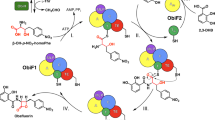Abstract
Gramicidin S synthetase 2 from B. brevis was affinity labeled at its valine thiolation center with the thiol reagent N-[3H]ethylmaleimide. From a tryptic digest of the enzyme–inhibitor complex a radioactive fragment was isolated in pure form by two reversed-phase HPLC steps. It was identified by liquid-phase N-terminal sequencing in combination with electrospray mass spectrometry (ESI-MS) as a hexadecapeptide containing the thiolation motif LGG(H/D)S(L/I). By ESI-MS it was demonstrated that a 4′-phosphopantetheine cofactor was attached to this fragment at its reactive serine. These results are consistent with the “Multiple Carrier Model” of nonribosomal peptide biosynthesis. Site-specific mutagenesis has been performed in thiolation, elongation, and epimerization motifs of some of the modules of surfactin synthetase from B. subtilis to clarify the function of prominent conserved amino acid residues in the intermediate steps of peptide biosynthesis. The modular structure of multifunctional peptide synthetases is discussed.
Similar content being viewed by others
REFERENCES
D'Souza, C., Nakano, M. M., Corbell, N., and Zuber, P. (1993). J. Bacteriol. 175, 3502–3510.
Kleinkauf, H., and von Döhren, H. (1996). Eur. J. Biochem. 236, 335–351.
Kurahashi, K. (1974). Annu. Rev. Biochem. 43, 445–459.
Laland, S. G., and Zimmer, T.-L. (1973). Essays Biochem. 9, 31–57.
Lipmann, F. (1973). Acc. Chem. Res. 6, 361–367.
Mann, M., Meng, C. K., and Fenn, J. B. (1989). Anal. Chem. 61, 1702–1708.
Menkhaus, M., Ullrich, C., Kluge, B., Vater, J., Vollenbroich, D., and Kamp, R. M. (1993). J. Biol. Chem. 268, 7678–7684.
Schlumbohm, W., Stein, T., Ullrich, C., Vater, J., Krause, M., Marahiel, M. A., Kruft, V., and Wittmann-Liebold, B. (1991). J. Biol. Chem. 266, 23135–23141.
Stachelhaus, T., and Marahiel, M. A. (1995). FEMS Microbiol. Lett. 125, 3–14.
Stein, T., and Vater, J. (1996). Amino Acids 10, 201–227.
Stein, T., Vater, J., Kruft, V., Wittmann-Liebold, B., Franke, P., Panico, M., McDowell, R., and Morris, H. R. (1994). FEBS Lett. 340, 39–44.
Stein, T., Kluge, B., Vater, J., Franke, P., Otto, A., and Wittmann-Liebold, B. (1995). Biochemistry 34, 4633–4642.
Stein, T., Vater, J., Kruft, V., Otto, A., Wittmann-Liebold, B., Franke, P., Panico, M., McDowell, R., and Morris, H. R. (1996). J. Biol. Chem. 271, 15428–15435.
Turgay, K., Krause, M., and Marahiel, M. A. (1992). Mol. Microbiol. 6, 529–546.
Vater, J., Schlumbohm, W., Palacz, Z., Salnikow, J., Gadow, A., and Kleinkauf, H. (1987). Eur. J. Biochem. 163, 297–302.
Vollenbroich, D., Mehta, N., Zuber, P., Vater, J., and Kamp, R. M. (1994). J. Bacteriol. 176, 395–400.
Mann, M., Meng, C. K., and Fenn, J. B. (1989). Anal. Chem. 61, 1702–1708.
Menkhaus, M., Ullrich, C., Kluge, B., Vater, J., Vollenbroich, D., and Kamp, R. M. (1993). J. Biol. Chem. 268, 7678–7684.
Schlumbohm, W., Stein, T., Ullrich, C., Vater, J., Krause, M., Marahiel, M. A., Kruft, V., and Wittmann-Liebold, B. (1991). J. Biol. Chem. 266, 23135–23141.
Stachelhaus, T., and Marahiel, M. A. (1995). FEMS Microbiol. Lett. 125, 3–14.
Stein, T., and Vater, J. (1996). Amino Acids 10, 201–227.
Stein, T., Vater, J., Kruft, V., Wittmann-Liebold, B., Franke, P., Panico, M., McDowell, R., and Morris, H. R. (1994). FEBS Lett. 340, 39–44.
Stein, T., Kluge, B., Vater, J., Franke, P., Otto, A., and Wittmann-Liebold, B. (1995). Biochemistry 34, 4633–4642.
Stein, T., Vater, J., Kruft, V., Otto, A., Wittmann-Liebold, B., Franke, P., Panico, M., McDowell, R., and Morris, H. R. (1996). J. Biol. Chem. 271, 15428–15435.
Turgay, K., Krause, M., and Marahiel, M. A. (1992). Mol. Microbiol. 6, 529–546.
Vater, J., Schlumbohm, W., Palacz, Z., Salnikow, J., Gadow, A., and Kleinkauf, H. (1987). Eur. J. Biochem. 163, 297–302.
Vollenbroich, D., Mehta, N., Zuber, P., Vater, J., and Kamp, R. M. (1994). J. Bacteriol. 176, 395–400.
Author information
Authors and Affiliations
Rights and permissions
About this article
Cite this article
Vater, J., Stein, T., Vollenbroich, D. et al. The Modular Organization of Multifunctional Peptide Synthetases. J Protein Chem 16, 557–564 (1997). https://doi.org/10.1023/A:1026386100259
Published:
Issue Date:
DOI: https://doi.org/10.1023/A:1026386100259




